
The beautiful sunbird, formerly placed in the genus Nectarinia, is a small passerine bird in the sunbird family Nectariniidae. It is native to tropical Africa, its range extending from Senegal and Guinea in the west to Sudan, South Sudan, Ethiopia, Tanzania and Kenya in the east. It was formerly considered to be conspecific with the gorgeous sunbird.
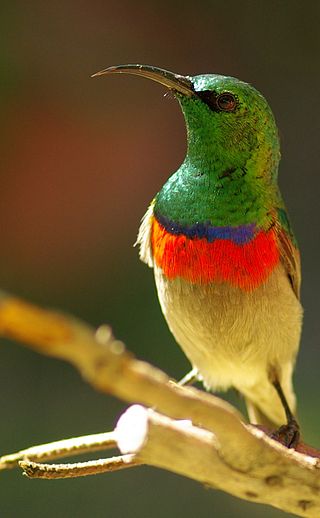
The southern double-collared sunbird or lesser double-collared sunbird is a small passerine bird which breeds in southern Africa. It is mainly resident, but partially migratory in the north-east of its range.
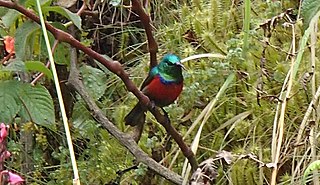
The Rwenzori double-collared sunbird, also called Stuhlmann's sunbird or the Rwanda double-collared sunbird, is a species of bird in the family Nectariniidae. It is found in the Ruwenzori range of mountains in south central Africa. Its natural habitat is subtropical or tropical dry forests. It is threatened by habitat loss. It is sometimes considered to be a subspecies of the greater double-collared sunbird. Some authors consider this bird to be part of a species complex with Cinnyris afer, where it joins Ludwig's double-collared sunbird and Prigogine's double-collared sunbird. As with other closely related species, each inhabiting different locations, there are subtle similarities and differences between the local populations, and their taxonomic treatment depends on the views of the taxonomist.

The souimanga sunbird is a small passerine bird of the sunbird family, Nectariniidae. It is native to the islands of the western Indian Ocean where it occurs on Madagascar, the Aldabra Group and the Glorioso Islands.

The Palestine sunbird is a small passerine bird of the sunbird family, Nectariniidae. Found in parts of the Middle East and sub-Saharan Africa, it is also known as the northern orange-tufted sunbird. However, the name "orange-tufted sunbird" refers to another species, found further south in Africa. In 2015, the Palestinian Authority adopted the species as a national bird, after losing in Israel's national bird public vote in 2008. The specific name osea is derived from Ancient Greek ὁσια.

Bates's sunbird is a species of sunbird in the family Nectariniidae which occurs in Western African forests and Central African rainforests, and locally in other types of forest in Central Africa.
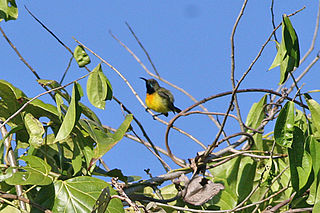
The apricot-breasted sunbird is a species of bird in the family Nectariniidae. It is endemic to the island of Sumba in Indonesia, where its natural habitats are subtropical or tropical moist lowland forests and subtropical or tropical moist montane forests. Although it is quite common, very little is known about its biology, with virtually nothing known about its breeding or diet.
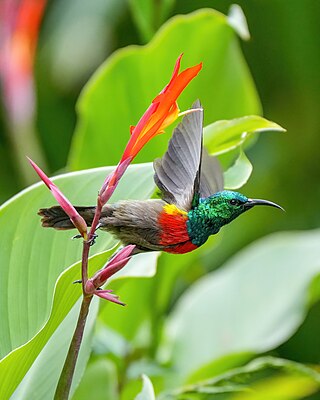
The olive-bellied sunbird is a species of bird in the family Nectariniidae. It is widely spread across the African tropical rainforest.

Humblot's sunbird is a species of bird in the family Nectariniidae. It is endemic to the islands of Grand Comoro and Mohéli in the Comoros.

The scarlet-tufted sunbird is a species of bird in the Nectarinia of the family Nectariniidae. It is found in Democratic Republic of the Congo, Kenya, Malawi, Rwanda, Tanzania, Uganda, and Zambia. It is also known as the red-tufted sunbird and the scarlet-tufted malachite sunbird.

The eastern double-collared sunbird is a species of bird in the family Nectariniidae. It is found in upland areas of Kenya and northern Tanzania.

The tiny sunbird is a species of bird in the family Nectariniidae. It is sparsely distributed across the African tropical rainforest.
Moreau's sunbird is a species of bird in the family Nectariniidae. It is endemic to Kilolo District of Morogoro Region in Tanzania where its natural habitat is subtropical or tropical moist montane forests. It is threatened by habitat loss and the International Union for Conservation of Nature has assessed it as being "near-threatened".

The black-bellied sunbird(Cinnyris nectarinioides) is a small sunbird located primarily in Africa. Two subspecies are recognized: the Cinnyris nectarinioides erlangeri, which is smaller and found in Ethiopia, Somalia, and Kenya; and the Cinnyris nectarinioides nectarinioides, which is larger and found in Kenya and Tanzania. This bird inhabits savannah, wetlands, and terrestrial freshwater areas.
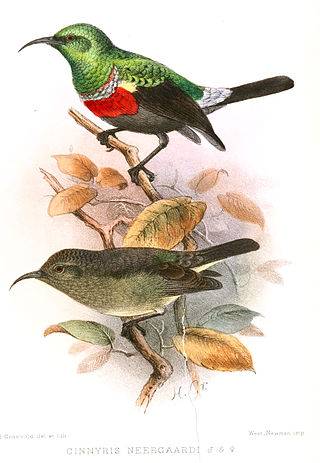
Neergaard's sunbird is a species of bird in the family Nectariniidae. It is found in Mozambique and South Africa. Its natural habitat is subtropical or tropical dry forest near the coast, where it is threatened by habitat loss. It is named after Paul Neergaard, a Danish recruiting officer for the Wenela agency, who was stationed in southern Mozambique.

The northern double-collared sunbird, is a species of bird in the family Nectariniidae. It is found in Burundi, Cameroon, Central African Republic, Democratic Republic of the Congo, Equatorial Guinea, Kenya, Nigeria, Rwanda, South Sudan, and Uganda.

The regal sunbird is a species of bird in the family Nectariniidae. It is native to the Albertine Rift montane forests.

Ludwig's double-collared sunbird or the montane double-collared sunbird, is a small passerine bird which breeds in forested mountains above 1,800 m (5,900 ft) in western Angola as well as the Nyika Plateau of northern Malawi and northeastern Zambia. This bird is sometimes considered to be con-specific with the greater double-collared sunbird. It is sometimes placed in the genus Nectarinia.

The grey-throated sunbird is a species of bird in the family Nectariniidae. It is found in a wide range of semi-open wooded habitats in the northern and eastern part of the Philippines. It is often considered a subspecies of the brown-throated sunbird, but the two differ consistently in measurements and plumage, and there is no evidence of intergradation between them.
The Mamberamo sunbird or Rand's sunbird, is a species of bird in the sunbird family Nectariniidae that is found in northern New Guinea. It was formerly considered to be a subspecies of the olive-backed sunbird, now renamed the garden sunbird.



















